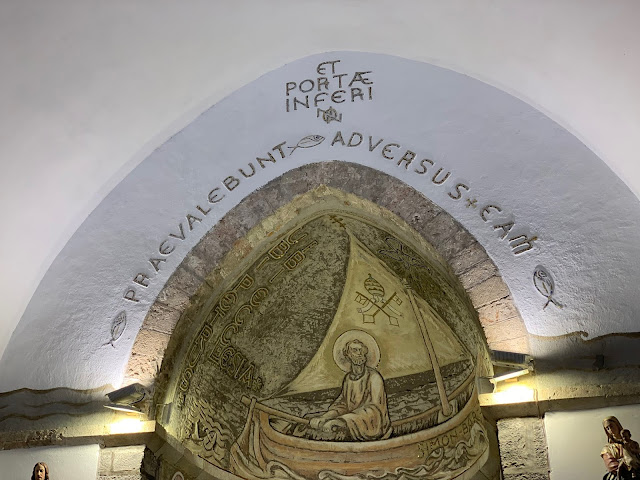After our morning at Mt. Tabor, site of the Transfiguration, we took a 20 minute bus ride to Nazareth, the hometown of Jesus. In the first century, Nazareth was off the beaten path; it is behind some hills and couldn't be seen from the main highway through Galilee. "Can anything good come out of Nazareth?" asked Nathanael in John 1:46, giving a hint as to its reputation.
First, we went to Mary's Grotto, where the Angel Gabriel, brought the good news to Mary. "Hail favored one! The Lord is with you! Do not be afraid, Mary, for you have found favor with God. Behold, you will conceive in your womb and bear a son and you shall name him Jesus. The Holy Spirit will come upon you and the power of the Most High will overshadow you. Therefore the child to be born will be called holy, the Son of God." Luke 1
The Basilica of the Annunciation was built over Mary's Grotto, where Gabriel visited Mary. In the Holy Land, there weren't Christian churches built until the 4th century, by St. Helena, the mother of the Roman Emperor Constantine. Before this, Christians met in homes or secret places. Constantine legalized Christianity within the Roman Empire and became a Christian himself. In the centuries after this, there was a lot of back and forth between the Muslims and the Christians during the Crusades. Churches/mosques would be built and then knocked down. Repeat. The above pictured Basilica of the Annunciation was constructed in 1969 and was built over the site of the Crusader church.
We had Mass in the Basilica and I was the lector. Above, Father Michael prepares.
A reading from the Book of the Prophet Isaiah 7:10-14, 8:10
The Lord spoke to Ahaz, saying: Ask for a sign from the Lord, your God; let it be deep as the netherworld, or high as the sky! But Ahaz answered, "I will not ask! I will not tempt the Lord!" Then Isaiah said: Listen, O house of David! Is it not enough for you to weary people, must you also weary my God? Therefore the Lord himself will give you this sign: the virgin shall conceive, and bear a son, and shall name him Emmanuel, which means, "God is with us!"
The word of the Lord.
As part of our pilgrimage, we had daily Mass, prayer services a few times each day, embodied Rosary, and liturgical skits and dances. All greatly enhanced our experience of the Holy Land. Above, Betsy performs a liturgical dance at the end of Mass.
The red bag to the right contains all of the prayer requests that we pilgrims brought from home. This bag is making the pilgrimage with us and is placed on the altar each day before Mass.
At many of the churches I visit, I take a photo of the Ninth Station of the Cross: Jesus falls the third time.
In the courtyard of the Church.
There are about 50 pilgrims on this trip. A couple of them are deaf and blind. Traveling with them are guides and interpreters. The interpreters do tactile signing. As the interpreters sign, they hold the hands of the pilgrim and through movement and tracing onto their hands, the interpreters are able to describe the sites and sounds of the different locations. These fellow pilgrims and interpreters are my heroes! Our fellow pilgrims were cheerful and slowed us up not one bit. The interpreters don't stop moving all day, and at all times, have to pay close attention to what is being said and what we are seeing. They did their work with such joy!
Next to the Basilica of the Annunciation was the Church of St. Joseph. It was built in 1914 over what tradition says was the workshop of St. Joseph.
A visitor relaxes on one of the pews in St. Joseph's.
Jesus works with Joseph in the workshop.


















































